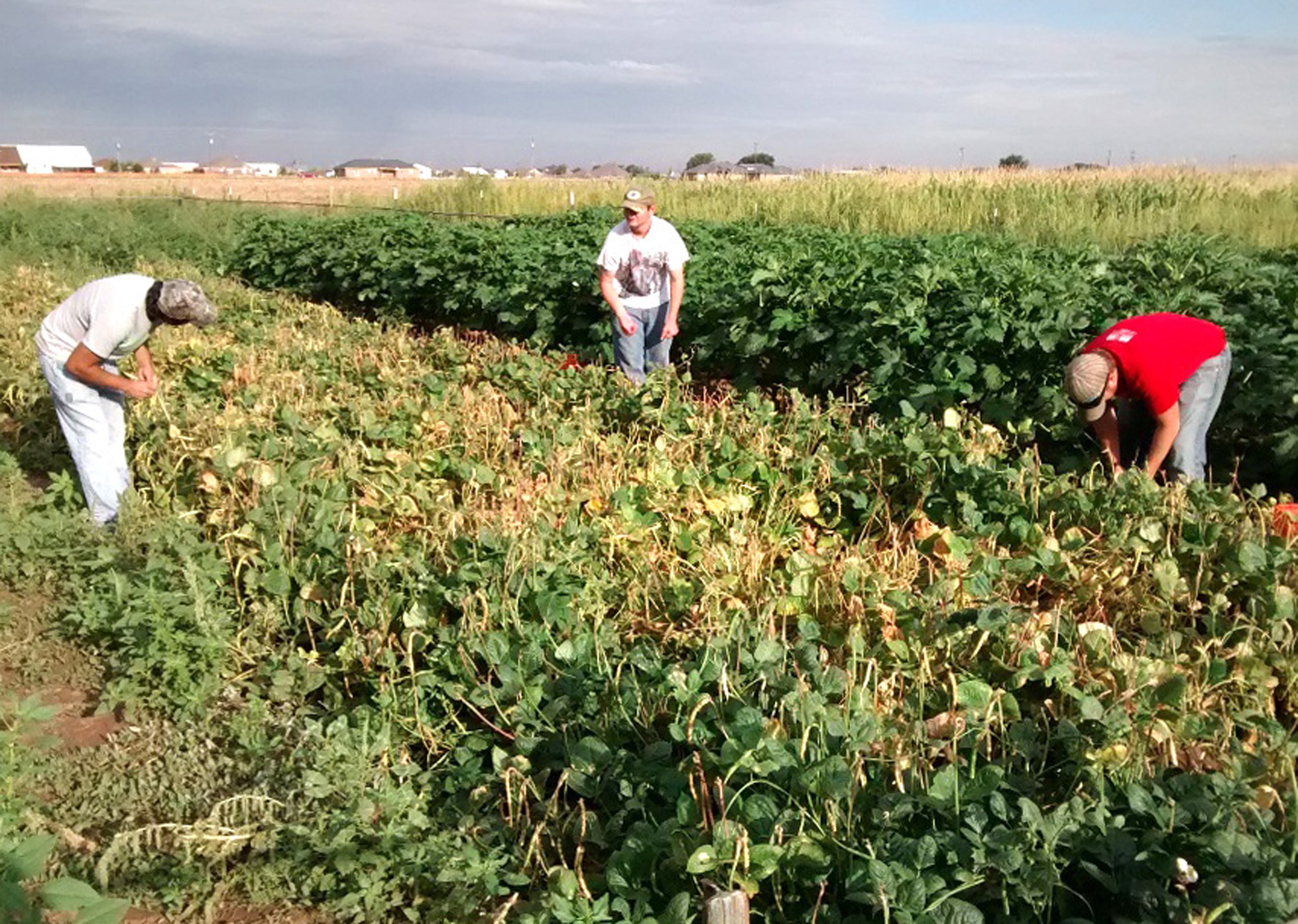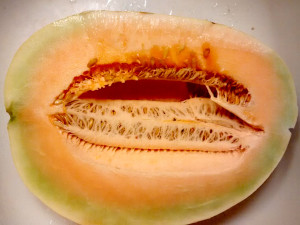Farm & Ranch
Vegetable study targets water saving in the high plains

By: Kay Ledbetter
Writer: Kay Ledbetter, 806-677-5608, [email protected]
Contact: Thomas Marek, 806-677-5600, [email protected]
AMARILLO – Vegetable production is not new in the Texas High Plains, but it is being re-examined in a Texas A&M AgriLife Research study to see if it might offer a water-savings alternative to some cereal grain production.

Texas A&M AgriLife Research student workers harvest peas from a study plot at the AgriLife Research James Bush Farm north of Bushland. (Texas A&M AgriLife Research photo)
“Everybody knows we are generally water short in the Texas High Plains and can no longer meet 100 percent of all crop water needs,” said Thomas Marek, AgriLife Research senior research engineer for irrigation water conservation and management in Amarillo. “We grow a tremendous amount of corn for the cattle industry. And we know from our regional water plan that corn production is going to have to be reduced in the future.”
Marek said production changes, preferably to higher valued crops such as certain types of vegetables, may be a partial solution to sustaining future profitability for Texas High Plains’ producers, particularly those within the northwestern area facing water shortages.
“Water is the largest input factor in economically feasible crop production, so numerous water management strategies have been proposed by the region’s water planning committee, the Panhandle Water Planning Group,” he said. “One of those strategies being considered is that of crop changes to reduce irrigation water use.

Cantaloupe grown in a Texas A&M AgriLife Research field study shows quality is reduced under deficit water conditions. (Texas A&M AgriLife Research photo)
“While water use for vegetables may not be less per acre than that of some currently produced cereal grains, less overall regional acreage may be required to potentially maintain or even increase existing profit levels for producers,” Marek said.
He conducted a relatively small demonstration in 2014 with several categories of vegetables at the AgriLife Research James Bush Farm north of Bushland. This study was supported by the U.S. Department of Agriculture Agricultural Research Service’s Ogallala Aquifer Program, AgriLife Research and the USDA National Institute of Food and Agriculture.
Marek said they grew the higher value runner-type vegetables such as squash, zucchini, cucumbers, as well as peppers, onions, melons, tomatoes, black-eyed peas and okra.
“We have a pretty definite range of what we are evaluating at this point,” he said. “The potential has been promising to date.”
All vegetables were grown under a single irrigation level targeted at a high evapotranspiration, known as ET, level. A weather station, which is part of the Texas High Plains Evapotranspiration Network, was located near the plots and was used to compute daily reference ET to know what the actual water demand was.
Plots were planted on May 29 and again on June 10. This was later than desired, but scheduling conflicts prevented earlier operations. Irrigation was applied using surface-flow irrigation. As the total plot area was relatively small, Marek said irrigation efficiencies were very high, and the total amount of irrigation applied from planting to harvest was 17.46 inches. The in-season rainfall in 2014 was 12.61 inches.
Each vegetable was evaluated on a bedded, two-row, 20-feet long plot size. Row spacing was 30 inches. Vegetables were hand-harvested on a two-to-three-day basis. Data regarding plant count, harvested fruit number, total harvested weight per picking and water use were recorded for each harvest event.
Several things Marek said they determined with the first round of the study were: earlier planting would help increase yield output per plant; and plant establishment with transplants needs to be augmented by the use of protective wind cylinders due to early season high wind speeds in 2014.
“We had area folks driving by the field who asked ‘what are all those white things out there in the field and what are y’all doing?’ so I knew the local community was paying attention to what we were doing,” he said.
Marek said they will need to look at the heat unit requirements to be sure vegetables can be routinely produced. Also, more research is needed regarding production water use and management within the region before adequate assessment can be made with vegetables as a viable water-saving alternative to current cereal grains production.
The demonstration-type assessment is planned again for 2015 and will be complemented with related projects in the Texas A&M AgriLife cropping system program with wheat stubble involving AgriLife Research scientists and Texas A&M AgriLife Extension Service specialists, he said.
“The results so far have been promising that we can produ
ce vegetables,” Marek said. “What’s going to be needed ultimately is to develop the needed market structure again. What we will continue to determine are the production aspects and water-use efficiency of various vegetables and determine what is most efficient over time.”
-30-
Farm & Ranch
Acorn Toxicity

By Barry Whitworth, DVM, MPH
With the prolonged drought, most pastures in Oklahoma end up in poor condition. With the lack of available forage, animals may go in search of alternative foods.
If oak trees are in the pastures, acorns may be a favorite meal for some livestock in the fall. This may result in oak poisoning.
Oak leaves, twigs, buds, and acorns may be toxic to some animals when consumed.
To read more, pick up a copy of the November edition of North Texas Farm & Ranch magazine, available digitally and in print. To subscribe by mail, call 940-872-5922.

Farm & Ranch
Silver Bluestems

By: Tony Dean
There are a handful of grasses on North Texas grazing lands ranchers need to know, not because they are highly desirable, but rather because they are not of much value. I call them “decom” plants, which is am acronym for “Don’t Ever Count On Me.” Silver bluestem is a “decom” grass.
Silver bluestem is a perennial which grows in all areas of Texas. It can survive in almost all soil types, and in full sun conditions or in semi shade. It grows up to three feet tall and is easily recognized with the presence of the white fuzzy seed head. Also, one of the identifying characteristics of Silver bluestem is a bend in the stems at each node, causing the plants to take on a rounded shape as they mature.
To read more, pick up a copy of the November edition of North Texas Farm & Ranch magazine, available digitally and in print. To subscribe by mail, call 940-872-5922.

Farm & Ranch
Meanwhile Back At The Ranch

By: Rayford Pullen
Fall is here which means winter is closing in on us and before we officially get into winter, we need to make sure our factories are either producing or will be producing in a few months.
We have been pregnancy testing our cows this fall and if they are not bred or nursing a calf, we are bidding them adios. With annual costs somewhere between $900.00 and $1,000.00 per cow, those cows not producing a live weaned calf are costing us quite a bit.
To read more, pick up a copy of the November edition of North Texas Farm & Ranch magazine, available digitally and in print. To subscribe by mail, call 940-872-5922.
-

 Country Lifestyles2 years ago
Country Lifestyles2 years agoScott & Stacey Schumacher: A Growth Mindset
-

 Country Lifestyles8 years ago
Country Lifestyles8 years agoStyle Your Profile – What your style cowboy hat says about you and new trends in 2017
-

 HOME8 years ago
HOME8 years agoGrazing North Texas – Wilman Lovegrass
-

 Equine1 year ago
Equine1 year agoThe Will to Win
-

 Country Lifestyles5 years ago
Country Lifestyles5 years agoAmber Crawford, Breakaway Roper
-

 Outdoor9 years ago
Outdoor9 years agoButtercup or Primrose?
-

 Country Lifestyles8 years ago
Country Lifestyles8 years agoJune 2016 Profile – The man behind the mic: Bob Tallman
-

 Country Lifestyles8 years ago
Country Lifestyles8 years agoDecember 2016 Profile, Rusty Riddle – The Riddle Way




